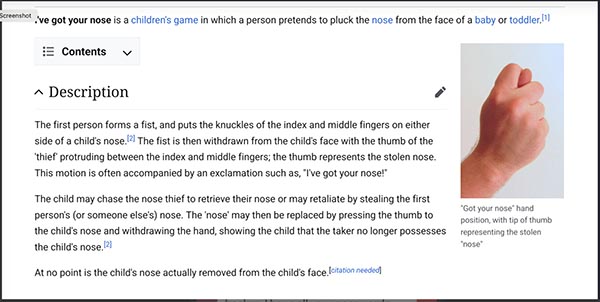World Book of Records
Our Mount Monadnock Media Maven points us to this article at Ars Technica about the World Book—the last remaining printed encyclopedia (even the venerable Encyclopedia Britannica ditched print in 2012).
Based in Chicago, World Book, Inc. first published an encyclopedia in 1917, and it has released a new edition almost every year since 1925. The company, a subsidiary of Warren Buffett’s Berkshire Hathaway, claims that its encyclopedia is “the only general reference encyclopedia still published today.” My research seems to back up this claim, at least in English; it's possibly true even for languages.
And the reason that it stays in print is that there is a demand for it.
Today, up-to-date information flows freely thanks to the Internet. It’s only a Google search away. Many people rely on Wikipedia, which is a nonprofit collaborative resource, for reference purposes. Despite that, some people and organizations apparently still buy paper encyclopedias. Evans said that sales of the print edition are “in the thousands” and that World Book always prints just enough copies to satisfy demand.
Public and school libraries are the primary customers, as well as homeschoolers. Still, it’s not cheap: the 2023 edition of World Book retails for $1,199, although you can subscribe to an online edition for $250 a year.
Back to the Future
Do you like ChatGPT? 1980s era computer technology? Well, then, take a little trip back with YouTuber Squirrel Monkey, who has reimagined ChatGPT for MS-DOS. All you’ll need is a “very fast” PC (like one running an Intel 286), 640KB RAM, a fast dial-up modem, a massive 20MB hard drive, and of course a set of installation diskettes.
Let’s go back to the future…
Imagine That
Via Core77, meet Soren Iverson.
For his day job, product designer Soren Iverson handles the Cash app’s UI. On the side, the L.A.-based designer, who has a wicked sense of humor, design concepts for “unhinged” UI features that no one asked for. With the perceptive eye of a stand-up comic, Iverson observes how people interact with commonly-used apps, then marshals his keen grasp of both human nature and business reality to present “Wouldn’t it be funny if…” design proposals…
Stuff like:
- An Uber Eats option to steal someone else’s meal.
- The ability in iMessage to show the number of times someone has read your message.
- A feature in BeReal Corporate that automatically takes photos of your screen and shares them with your manager.
- A Facebook feature that will tell you if people read an article before they shared it.
And a couple of our favorites:
The Fidelity app will project your retirement age:

Tinder will let you know how old a photo is:

The United Airlines app will let you “duel” other travelers for their seat.

Iverson has compiled 100 of his favorites into a book called Can You Imagine?, which can be pre-ordered here ($40). You bet we will.
The Nose Knows
Now, we know it’s important to verify purported facts, especially if you are an online encyclopedia. However, sometimes, Wikipedia’s “citation needed” tag can call for additional evidence even though the assertion should be, well, as plain as the nose on one’s face. Via Boing Boing, Wikipedia has an entry for “I’ve got your nose”:

“At no point is the child’s nose actually removed from the child’s face. [citation needed]” is what makes it art.
Graphene Wears Well Again
Was it a good week for graphene news? It’s always a good week for graphene news! Yet another leap forward for graphene-based wearable textiles, in this case, eco-denim. From (who else?) Graphene-Info:
Directa Plus has partnered with Candiani Denim, an Italian textile producer focused on innovation and sustainability, to launch GRAPHITO, an eco-denim textile. The eco-friendly denim textile combines Directa Plus' patented technology, providing antimicrobial and thermal properties, with Candiani Denim's bio-based polymer, which replaces liquid plastic in textile production.
… Graphito jeans can reportedly be worn 10 times before washing them and this reduces water usage by 75%. In addition, Jeans impregnated with G+ reportedly measured lower skin temperature and a higher external surface temperature, an indication of better heat dissipation and thermal comfort for the user.
After the 10 wearings, the jeans will walk themselves to the washing machine.
Take My Wyffe, Please
We all know that back in the Middle Ages, minstrels, jesters, and the like were the entertainers of their day. But scholars never really had a clear idea of what their shtick actually was. Until recently, when James Wade, a literary scholar at the University of Cambridge, took a close look at the content of the Heege manuscript, a 15th-century text housed in the National Library of Scotland. Via Smithsonian:
“It gives us a glimpse into live comedy and entertainment in the Middle Ages that would otherwise be lost,” says James Wade, a literary scholar at the University of Cambridge, to the Washington Post’s Leo Sands.
Wade is the author of a new study on the text published in The Review of English Studies. While the manuscript has been studied before, previous research focused primarily on its physical characteristics and significance as an artifact.
The manuscript contains a wide range of comedic acts. One takes the form of a satirical sermon from a preacher, extolling the virtues of heavy drinking. Another is an “alliterative nonsense verse” titled “The Battle of Brackonwet.” The text also features the first known use of the term “red herring” in English.
So basically medieval minstrels were the stand-up comics of their day. Since few were literate, they relied on performing from memory rather than writing it down.
Wade theorizes that this particular minstrel wrote down his act because it would have been especially difficult to recite by heart. “He didn’t give himself the kind of repetition or story trajectory which would have made things simpler to remember,” he says in a statement.
Star Diamond
The fate of many stars, after they have burned off all their fuel, is to collapse into what are known as a white dwarf. Sounds bad, but as it turns out, for stars whose cores comprised mostly metallic oxygen and carbon, the end result is the star crystallizing into a giant diamond. Now, before any would-be Blofelds go poking around in the heavens, bear in mind that the process of “diamondization” is so slow that any star has actually undergone this transformation—scientists estimate it would take one quadrillion years, and the universe is only a scant 13.6 billion years old.
That said, one star may be in the process of gaining diamond status. Says LiveScience:
The star, dubbed HD 190412 C, is about 104 light-years away in a quadruple star system called HD 190412. The researchers calculated the star’s temperature – about 11,420 degrees Fahrenheit (6,300 degrees Celsius) – which puts it into the range of a crystallizing white dwarf. Because the system has other stars that have not yet collapsed into the white dwarf state, the researchers were able to use those still-burning star compositions to determine how much metal is in the white dwarf’s core. They also calculated the star’s age at about 4.2 billion years.
…[T]he team modeled the white dwarf’s cooling over time, confirming the first case of a crystallizing white dwarf with a known age. Because there are other systems similar to HD 190412, including the star system that is home to the bright star Sirius, the researchers report that other crystallizing white dwarfs might be nearby in the cosmic neighborhood.
It will take some time for the process to play out, so for now our supply of diamonds will still have to come from the Earth.
Upstairs…Downstairs?
Sure, you may like your Roomba, but can it climb stairs? Via Core77, Migo Robotics has developed a robot vacuum that can climb stairs, so there is no escape from it. Called the Migo Ascender, it vacuums (and can supposedly mop, as well) the stairs as it climbs. It is estimated to ship in August, and will retail for $1,400 (yikes). However, if you buy early, they’ll cut $400 off the price.
No indication, though, if it can descend a staircase.
Dog Day Afternoon
What is the future of dogs? An odd question? To be sure! But it came up in a recent video posted to Laughing Squid. Zac Alsop entered his Unitree Go1, a quadrupedal, vaguely doglike robot, to compete in the agility course portion of a prestigious British dog show. Alsop had worked with renowned dog trainer Gina Pink and choreographer Alice Dardenne to get “Roobot” (his proper dog is named Roo) ready for their big day. Remarked Alsop:
Apparently this is the future of dogs… It doesn’t bark, it doesn’t pee in the house. So to prove it’s the future I entered my robot dog into a prestigious dog show to try and beat the real thing.
Yeah, no. Things did not go as planned…
Big Wheel
Elsewhere in the world of strange British competitions, a woman was knocked unconscious while chasing a 3 kg/7 lb. wheel of cheese down a hill. Two things about that: it is actually a competition (chasing a wheel of cheese, not being knocked unconscious) and she actually won. From The Guardian:
Video footage posted on social media showed Delaney Irving falling while pursuing the double gloucester down the almost-vertical Coopers Hill in Brockworth, near Gloucester.
?? Canadian ???? Delaney Irving won’t remember much of winning the Woman’s race at #cheeserolling.
— Greatest Hits Radio Gloucester (@GHRGloucester) May 29, 2023
After being knocked out on her way down, she was unconscious for a period of time but told us it was all worth it.
?? WARNING: Contains graphic images pic.twitter.com/yxwk0YaGUE
Irving, 19, said she only realised she had won the women’s race when she woke up in the medical tent.
It apparently draws people from all over the world, for reasons passing understanding.
Several races were held over the day and Matt Crolla, 28, from Manchester, won the first. Asked how he prepared, he acknowledged: “I don’t think you can train for it, can you? It’s just being an idiot.”
Angel’s Share
Back in March, we linked to a case that was headed to the Supreme Court, namely, that Jack Daniels—the whiskey maker—was suing VIP Products LLC—a maker of dog toys—over a squeak toy that resembled a Jack Daniels whiskey bottle. Well, the nine wise souls ruled 9-0 against parody products, demonstrating that they have absolutely no sense of humor. Wrote Justice Elena Kagan, in all seriousness:
Bad Spaniels is about the same size and shape as an ordinary bottle of Jack Daniel’s. The faux bottle, like the original, has a black label with stylized white text and a white filigreed border. The words “Bad Spaniels” replace “Jack Daniel’s” in a like font and arch…. Below the arch, “The Old No. 2 On Your Tennessee Carpet” replaces “Old No. 7 Tennessee Sour Mash Whiskey” in similar graphic form. The small print at the bottom substitutes “43% poo by vol.” and “100% smelly” for “40% alc. by vol. (80 proof ).”

Of course, the fact that one is sold in a liquor store and the other sold in a pet store is irrelevant.
Back in the High Life
We have linked often in this space to the Oscar Mayer Wienermobile Frankmobile, but there is another food-shaped vehicle on the road: the Planters NUTmobile. (And as it turns out, the NUTmobile has been cruising America’s byways since 1935, some years before the Wienermobile.)
Now, via Food & Wine, the NUTmobile is parking for a bit and will become what Planters is calling “the Nuttiest Dive Bar.”
Starting this Friday, anyone in Milwaukee, Wis., the week of July 9 can book the NUTmobile to kick back and enjoy a few snacks and drinks.
The collaboration between Planters and Miller High Life is putting itself up for reservations which open on June 16. Those lucky enough to score a spot will get the entire bar for 90 minutes at a cost of just $3.99 (the “price of peanuts,” as it were), but all of the warm peanuts and cold beer will be free.

They include a bullet point list of attractive features, although number one seems a bit less appealing: “An authentic dive bar smell that transports you to the closest Miller High Life.” They add:
In case you’re wondering how that “authentic dive bar smell” is achieved, a representative tells me it’s a combination of peanuts, High Life, sweet tobacco, and mahogany aromas delivered via a scent machine.
We’re not sure that makes it better.
[T]he Nuttiest Dive Bar will be located at 4251 State Street in Milwaukee — which just so happens to be the address of the Miller brewery's visitor center and gift shop. The bar will only be open starting Sunday, July 9 from 12 p.m. to 6:30 p.m. and then Monday through Wednesday from 2 p.m. to 9 p.m. Book your own experience (for guests 21 and up, only) on Tock or find more info and enter contests for some freebies at millerhighlife.com/nuttiestdivebar.
Did anything catch your eye “around the Web” this week? Let us know at [email protected].
This Week in Printing, Publishing, and Media History
June 12
1817: The earliest form of bicycle, the dandy horse, is driven by Karl von Drais.
1916: American director and producer Irwin Allen born.
1920: American cartoonist Dave Berg born.
1939: Shooting begins on Paramount Pictures’ Dr. Cyclops, the first horror film photographed in three-strip Technicolor.
1939: The Baseball Hall of Fame opens in Cooperstown, N.Y.
1949: English singer-songwriter, bass player, and producer John Wetton born.
1959: American singer-songwriter and musician John Linnell born.
1985: American computer programmer and co-creator of Mozilla Firefox Blake Ross born.
June 13
1865: Irish poet and playwright W. B. Yeats born.
1971: The New York Times begins publication of The Pentagon Papers.
1983: Pioneer 10 becomes the first man-made object to leave the central Solar System when it passes beyond the orbit of Neptune.
June 14
1618: Joris Veseler prints the first Dutch newspaper Courante uyt Italien, Duytslandt, &c. in Amsterdam (approximate date).
1822: Charles Babbage proposes a difference engine in a paper to the Royal Astronomical Society.
1933: Polish-American novelist and screenwriter Jerzy Kosi?ski born.
1936: English essayist, poet, playwright, and novelist G. K. Chesterton dies (b. 1874).
1951: UNIVAC I is dedicated by the U.S. Census Bureau.
1966: The Vatican announces the abolition of the Index Librorum Prohibitorum (“index of prohibited books”), which was originally instituted in 1557.
June 15
1752: Benjamin Franklin proves that lightning is electricity.
1878: To settle a bet, Eadweard Muybridge takes a series of photographs to prove that all four of a horse’s hooves leave the ground when it runs. The results become the basis of motion pictures.
June 16
1903: The Ford Motor Company is incorporated.
1904: Irish author James Joyce begins a relationship with Nora Barnacle and subsequently uses the date to set the actions for his novel Ulysses; this date is now traditionally celebrated as “Bloomsday.”
1911: IBM is founded as the Computing-Tabulating-Recording Company in Endicott, N.Y.
1917: American publisher Katharine Graham born.
June 17
1882: Russian pianist, composer, and conductor Igor Stravinsky born.
1898: Dutch illustrator M. C. Escher born.
1901: The College Board introduces its first standardized test, the forerunner to the SAT.
June 18
1466: Italian printer Ottaviano Petrucci born.
1812: Russian author and critic Ivan Goncharov born.
1854: American publisher and founder of the E. W. Scripps Company E. W. Scripps born.
1858: Charles Darwin receives a paper from Alfred Russel Wallace that draws eerily identical conclusions about evolution as Darwin had been developing. Darwin thus races to publish his own conclusions.
1942: Paul McCartney born.
1948: Columbia Records introduces the long-playing (LP) record, which, curiously, is seeing a bit of a renaissance today as a medium for delivering music.














